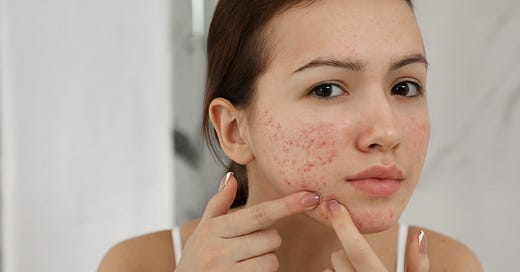The willow tree's gift to treating acne
I explore how salicylic acid—a plant hormone from the willow tree—helps to eliminate acne and warts!
As a mom of three teenagers, dealing with acne is a constant struggle in our household. My kids are bombarded by social media ads and TikTok videos promoting miracle cures, which has led to a flood of questions about homemade remedies and expensive commercial products.
Over-the-counter (OTC) acne products abound on store shelves. These range from budget items priced at under $5 to luxury skincare lines that cost upwards of $100. However, the truth behind the marketing hype is that all OTC products for acne in the U.S. are beholden to the Food and Drug Administration’s Monograph M006: Topical Acne Drug Products for Over-the-Counter Human Use.
Here’s the official list of acne-active ingredients approved in the monograph for OTC use:
Salicylic acid, 0.5 to 2 percent.
Benzoyl peroxide, 2.5 to 10 percent.
Resorcinol, 2 percent, when combined with sulfur in accordance with M006 rules.
Resorcinol monoacetate, 3 percent, when combined with sulfur in accordance with M006 rules.
Sulfur, 3 to 10 percent.
Sulfur, 3 to 8 percent, when combined with resorcinol or resorcinol monoacetate in accordance with M006 rules.
Translation: This means by law, all OTC acne products can only contain the above permitted acne-active ingredients within a specific percentage range and with only certain approved combinations. Read the product labels when comparison shopping and you’ll quickly see the same active ingredients from this short list.
Question: If all OTC acne products are only allowed to have one of these specific active ingredient formulations, why are some product lines so expensive? Answer: Marketing and brand power, not science. Takeaway: Read the labels and save some money. The most expensive products have the same % range of acne-active ingredient as the cheap store brands.
What is salicylic acid?
Salicylic acid (SA) is a plant hormone that is naturally produced in certain species, such as willow and sweet birch trees, as well as in the meadowsweet herb, among others. It serves as a natural defense mechanism for these plants against infections. When plants are attacked by microbes or insects, they increase their production of SA to help protect themselves.
Acne definitions

Before we dive into the science of how SA works to fight acne, it’s important to gain some clarity around the terminology. Here’s an important list of terms defined in the FDA monograph document:
Acne. A disease involving the oil glands and hair follicles of the skin which is manifested by blackheads, whiteheads, acne pimples, and acne blemishes.
Acne blemish. A flaw in the skin resulting from acne.
Acne drug product. A drug product used to reduce the number of acne blemishes, acne pimples, blackheads, and whiteheads.
Acne pimple. A small, prominent, inflamed elevation of the skin resulting from acne.
Blackhead. A condition of the skin that occurs in acne and is characterized by a black tip.
Whitehead. A condition of the skin that occurs in acne and is characterized by a small, firm, whitish elevation of the skin.
How does SA work to treat acne?
SA causes skin cells to slough off and prevents the buildup of oil and debris in the pores. By encouraging exfoliation, SA can help to unclog pores and reduce the likelihood of acne breakouts, also decreasing redness and inflammation.
Side effects of topical SA for acne
Skin reactions such as peeling, burning, and dry skin may occur, especially when you first start using SA for acne.
What are the other uses of SA?
In addition to the topical treatment of acne, at higher concentrations SA can be used as a keratolytic therapy to effectively remove warts. Depending on how the product is formulated, topical wart removers may contain anywhere between 5-40% SA according to the FDA OTC Monograph on Wart Removers. Never apply a wart remover SA product to normal skin or acne breakouts as the higher percent of SA can be very harsh on normal and sensitive skin.
A keratolytic therapy is a medical treatment intended to eliminate warts, calluses, and other skin lesions caused by the excessive production of skin by the epidermis.
In addition to topical uses, SA was once used as an oral medication for pain. However, the toxicity and harsh side effects of SA on the gastrointestinal tract limited its utility for this purpose. In the 1800s, a chemist made a small change to the structure of SA, creating acetylsalicylic acid—more commonly known as aspirin. Today, aspirin is used to relieve pain, reduce fever and inflammation, and prevent the occurrence of heart attacks, strokes, and blood clots.
What if topical OTC products like SA aren’t enough?
If OTC treatments aren’t working to manage your acne, the good news is that there are several prescription medication options available under the care of a dermatologist. See your doctor to determine which treatment plan is best for you.
Yours in health, Dr. Quave
Cassandra L. Quave, Ph.D. is a disabled writer, speaker, podcast host, wife, mother, explorer, ethnobotanist, and professor at Emory University School of Medicine. She teaches college courses and leads a group of research scientists studying medicinal plants to find new life-saving drugs from nature. She hosts the Foodie Pharmacology podcast and writes the Nature’s Pharmacy newsletter to share the science behind natural medicines. To support her effort, consider a paid or founding subscription, with founding members receiving an autographed 1st edition hardcover copy of her book, The Plant Hunter.







Cool info! And...good title:)